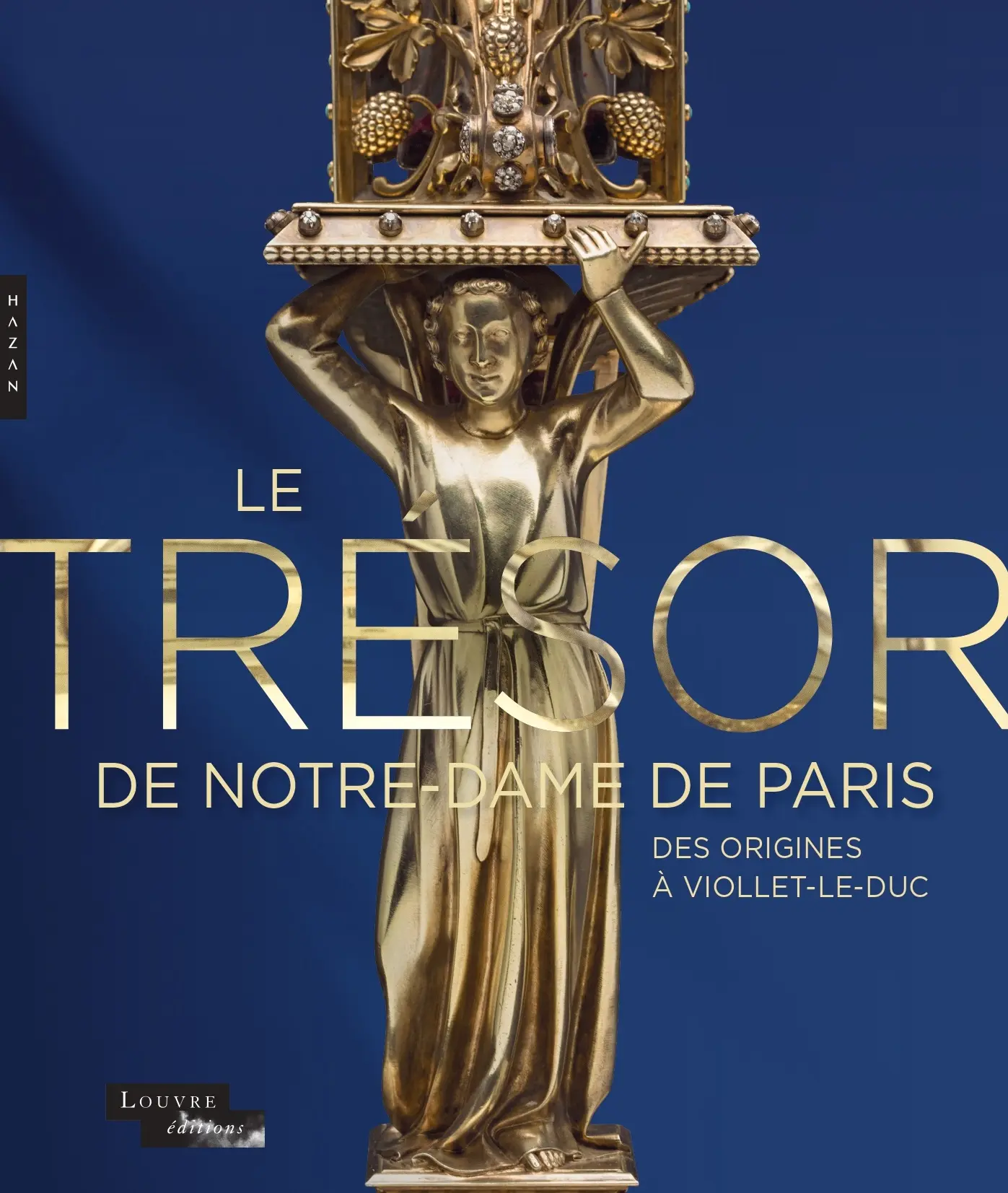Colleen’s Paris Exceptional Notre-Dame Treasures on the Louvre
How does one modernize thirteenth century designs? Maintain a contest. Little did Eugène Viollet-le-Duc know when he sketched the sacking of the archbishop’s residence in 1831 that he and a accomplice, Jean-Baptiste Lassus would win a contest in 1843 to revive Notre-Dame de Paris and its treasury.
For a really brief time, whereas twenty-first century restoration work continues on the cathedral of Paris, historic treasures are being saved on the Louvre Museum. The present exhibition on the Louvre ‘The Treasury of Notre-Dame Cathedral: from its Origins to Viollet-le-Duc’ showcases a minimum of 120 of these treasures, and runs till January 29, 2024. It places into context the treasury’s historical past from its origins within the Center Ages via the Second Empire within the mid 1800s. In just a few small rooms of the Louvre Museum, my eyes marveled on the intricate jewels of expertise that had been saved from the 2019 hearth.
What I cherished was the element of the work. I needed to undergo the exhibit twice, have a look at the catalog, see what I had missed and return and have a look at the objects once more. The treasury historical past is fascinating as a result of I initially solely considered Viollet-le-Duc. The exhibit places the timeline of the cathedral’s historical past into perspective.
The exhibition ticket is free, however should be reserved for time-stamped entry. The ticket is separate from the common Louvre Museum entrance ticket.
Tales Behind the Treasury Story
Two of the exhibition’s magazines, “Connaissance des Arts” and “Dossiers de l’Artwork” are filled with background, historical past and shut up photographs. They’re vital memento. The publications are in French, however you should utilize a translation app in your telephone to learn the tales. The two Press Releases in English comprise many information and historical past that assist tie collectively this retrospective. That is an exhibition well worth the go to once you go the Louvre Museum.
An 1831 drawing within the exhibition by Viollet-le-Duc exhibits that he was already attentive to Notre-Dame de Paris and its perils earlier than he turned the cathedral’s neo-Gothic restorer. He and Lassus received the 1843 competitors to revive the cathedral. They’d not solely restore the cathedral, however reconstruct the treasury vestry and reinterpret the treasures updating the thirteenth century medieval type.
He up to date liturgical furnishings and reliquaries within the new “revival gothic” type. The sculptor Jean Alexandre Chertier and the goldsmith Placide Poussielgue-Rusand interpreted Viollet-le-Duc’s designs. A number of the most lovely objects are: the reliquary for the crown of thorns, the reliquary for the cross, the bust of Saint Louis and the dove for the holy oils.
Within the Tracks of its Historical past
The exhibition is a retrospective of the treasury previous to the French Revolution and thru the restoration from 1843 to 1864. It features a chronological historical past of inventories, historic accounts, books, work, sketches, vestments, illuminated manuscripts, prints and illustrated paperwork.
The lengthy historical past begins within the Merovingian period. The primary proof of a treasury dates again to the sixth century. The treasury grew over time with donations from kings, queens, princes, bishops, canons and the “mysterious” Marquise de Neuchèze.
This philanthropy continued via the Bourbon Restoration in the course of the reign of Louis XVIII (1814-1830). Louis XVIII changed Napoleon, one other massive contributor to the Notre-Dame treasury for his coronation. Some gadgets initially within the Notre-Dame stock and proven within the exhibit had been dispersed to different nations, museums or church buildings over the centuries.
The Treasury as a Supply of Discontent
The 2019 hearth was not the primary time, the cathedral suffered. The cathedral’s treasury went via devastation in the course of the French Wars of Faith within the late 1500s and three assaults in the midst of sixty years in the course of the Revolutions of 1791, 1830 and 1831. Something not held down appeared open recreation for the malcontent, anti-Catholic revolutionaries. In distinction, the revolution of 1848 and the Commune 1871 didn’t contact any church treasury nor the cathedral. The constructing, to the French, represented an anti-papist historical past and stays a French nationwide image.
Over the centuries, the treasures have been dispersed to personal collections, different museums and archives. They’ve been taken aside, melted down after which replenished. In November 1789, Church property was nationalized. In March 1791, objects ‘ineffective for worship’ had been confiscated and melted down. The remaining objects had been taken by tumbril to the Hôtel de Ville in August 1792 and melted down in October on the Hôtel de la Monnaie (Paris Mint).
New treasures had been bought for Napoleon’s coronation. Then got here the 1830 July revolution with looting and destruction of the archbishop’s residence and the treasury vestry, and repeated with the riot of February 1831. The destruction was so dangerous of those constructions, they needed to be torn down.
This can be the one time for an extended whereas to view these treasures in a single exhibition. The subsequent time can be when the restoration is accomplished. At the moment, about one thousand treasures will return to the Notre-Dame vestry. Donations for the restoration work on the cathedral might be made on the Notre-Dame de Paris web site. Observe the progress of the restoration on the Rebuild Notre Dame web site and steadily on Instagram @rebatirnotredamedeparis (The coq/rooster on high of the fleche/spire is now in place).
Testomony of Erminethrudis or Ementrude, about 575, copy from the seventh century, Merovingian aristocracy, stock of donations to the cathedral of Paris, ink on papyrus, Archives nationales de France
Stock of the Treasury of Notre-Dame in 1438, stock of relics, jewels, ornaments, fabric of gold and silk,, tapestries, books and different issues belonging to the treasury of the church of Paris, Nationwide Archives of France
Breviary (consisting of psalms, Scripture classes, writings of the Church Fathers, in addition to hymns and prayers) for the usage of by the Dauphin Louis of France, about 1413-1414, Parchment
Porphyry vase “Suger’s Eagle”, pre-1147 inspiration for the Chrismarium of 1866 igneous rock with massive crystals on show within the Louvre
Porphyry vase “Suger’s Eagle”, pre-1147 inspiration for the chrismatory dove of 1866, igneous rock with massive crystals, a part of the Louvre assortment
Chrismatory/vessel within the form of a Dove for the Holy Oils used throughout Mass, 1866. Jean-Alexandre Chertier after Viollet-le-Duc, silver gilt and champlevé enamel, Treasury of Notre-Dame Cathedral
Design for the Reliquary of the True Cross and the Holy Nail, 1862 watercolor
Reliquary of the True Cross and the Holy Nail 1862, Placide Poussielgue-Rusand after Eugène Viollet-le-Duc, Treasury of Notre Dame Cathedral, gold-plated silver, pearls and treasured stones
Design for the Reliquary of the Holy Crown of thorns, 1859-1860 Graphite, pen and black ink, watercolor Eugène Viollet-Le-Duc
Reliquary for the Holy Crown of thorns, 1862 Element of the Placide Poussielgue-Rusand silver and bronze plated with gold
Reliquary for the Holy Crown of thorns, 1862 Element of the Placide Poussielgue-Rusand silver and bronze plated with gold
Monstrance Element Viollet-le-Duc, March 20, 1866, drawing, ink, wash on paper mounted on cardboard
Monstrance, 1867 4 evangelists – Element-Placide Poussielgue-Rusand after Viollet-le-Duc, gold-plated silver and treasured stones
Monstrance, 1867. Placide Poussielgue-Rusand after Viollet-le-Duc, gold-plated silver and treasured stones
Monstrance Element Viollet-le-Duc, March 20, 1866, drawing, ink, wash on paper mounted on cardboard
Reliquary of the Nail and the Wooden of the Cross, 1862 Element – Placide Poussielgue-Rusand after Eugène Viollet-le-Duc, Treasury of Notre Dame Cathedral, gold-plated silver, pearls and treasured stones
Reliquary for the Holy Crown of thorns, 1862 Element of the Placide Poussielgue-Rusand silver and bronze plated with gold
Bust of Saint Louis, 1867 and 1869 Jean-Alexandre Chertier after Viollet-le-Duc, Treasury of Notre-Dame Cathedral, silver, wooden core, enamel, glass cabochons
Bust of Saint Louis, 1867 and 1869 Jean-Alexandre Chertier after Viollet-le-Duc, Treasury of Notre-Dame Cathedral, silver, wooden core, enamel, glass cabochons
Epistolary (letters), Missal and Gospels 1867-1868, Jean-Alexandre Chertier after Viollet-le-Duc, Treasury of Notre-Dame Cathedral, gilded and enameled copper, silver gilt pink morocco
Viollet-le-Duc and the scholar Adolph Didron had been fooled by this reliquary. He recognized it as medieval, nevertheless it was produced round 1850. The Marquise of Neuchèze bequeathed fourteen reliquaries to the cathedral in 1864, the 12 months of her loss of life. Gilded bronze, agate, comaline, glass
The post Colleen’s Paris Exceptional Notre-Dame Treasures on the Louvre appeared first on Havens travel and tour blog .




